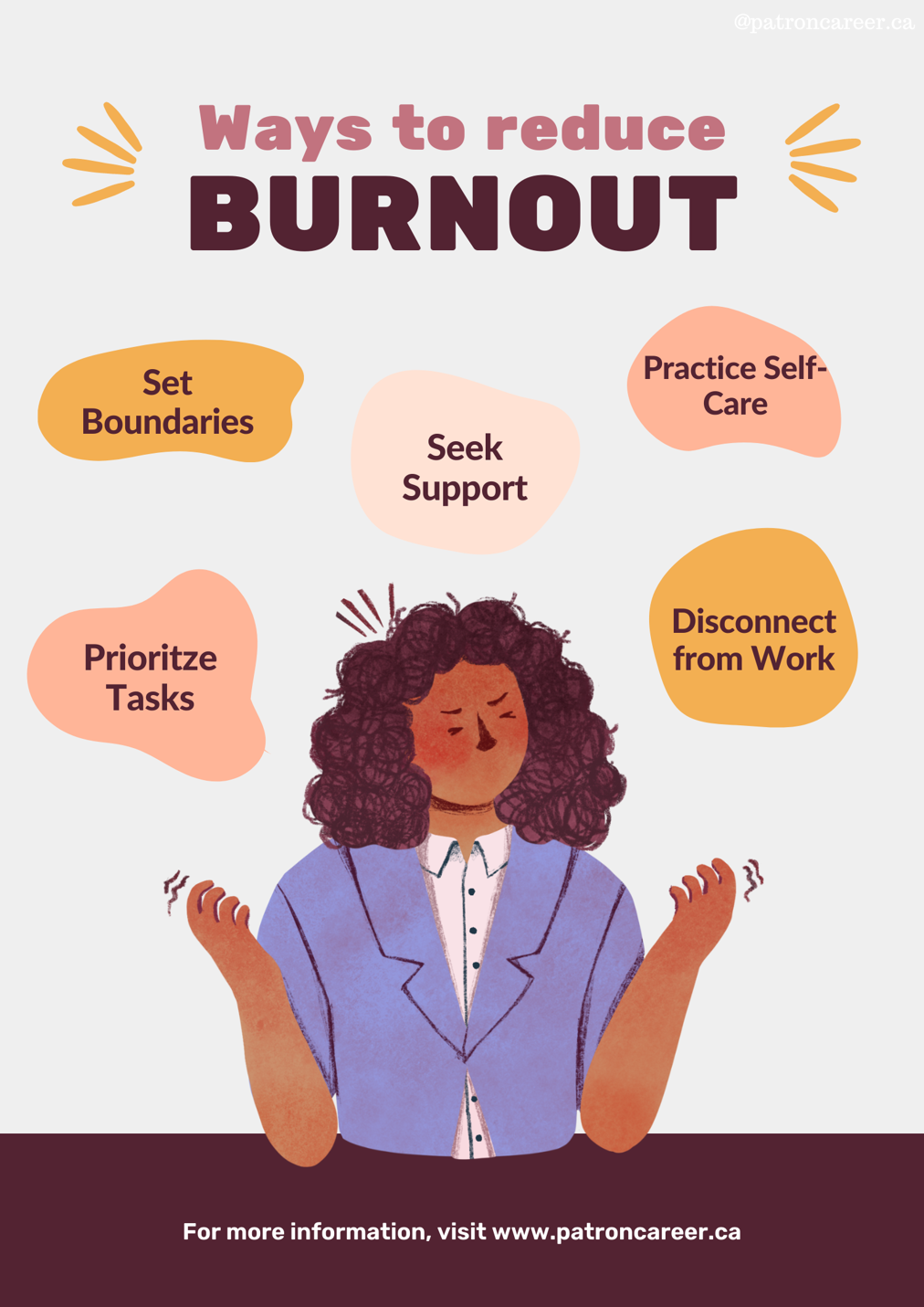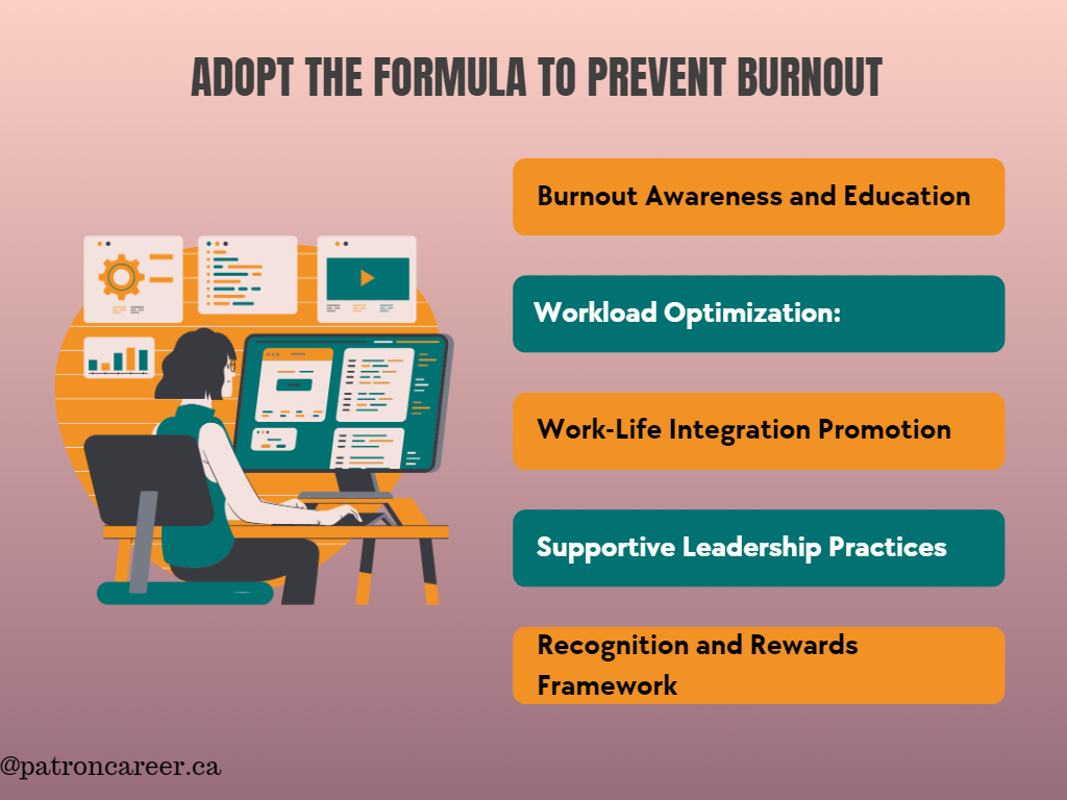
Crucial Role Of Upskilling
19 June, 2023
Patron Career Staffing firmly believes in adopting a tailored approach to meet temporary and permanent recruitment needs. We safeguard the interest of our clients by finding such workers who are knowledgeable and reliable.
About UsNeed help? Make a Call
32 Dundas Street East Unit A, L5A1W2

The average Canadian full-time employee spends about 36.6 hours at work per week, which is approximately 7.3 hours per day assumingly on a 5-day workweek. He spends most of his life’s time engaging in a work environment that imposes overwhelming expectations, high demands and everyday conflicts that take a toll on the employee. Employees, bosses, HR and even company leaders are prone to a chronic condition that’s termed burnout. This is a serious issue that requires constant attention and measures in place to prevent its occurrence.
Now, more than ever, the pressure to shed light on the pressing phenomenon of job burnout has become more prevalent. Companies, though big or small, don’t want to leave little to no chance of losing top talent due to unsuccessful management and lack of a support system at work.
This article is dedicated to all those employers and employees who have suppressed themselves under the garb of utter stress and burnout. Take the time to read, understand and address the underlying concerns surrounding burnout and unhappiness at work.
Recognizing Burnout
To shun the ordeal away, one needs to know what’s incessantly bothering them. Similarly, before jumping into preventive measures, it's important to learn the A-Z of burnout.
AAn important definition of burnout is given by the World Health Organisation- burnout is a syndrome conceptualized as resulting from chronic workplace stress that has not been fully managed. This description focuses on how people at work might be dealing with exhaustion, excessive stress, detachment from work and forlornness. All of this hints towards a serious ailment that is both mentally and physically exhausting.
Let’s dive into knowing the commonly occurring symptoms:
1. Exhaustion: feeling weary and tired is no rare occurrence at workstations. The fatigue escalates when it is combined with the body and mind being drained the majority of the time at work. There can be several reasons, including being overladen with work, the pressure of fulfilling deadlines, role conflict and ambiguity.
2. Distress: hardships at home or work may cause a person to feel agitated, alienated and anxious. They might be suffering themselves and even acting snappishly towards co- workers.
3. Lessened efficacy: isn’t that obvious? Burnout leads to absenteeism, loss of productivity and efficiency in completing tasks and work assignments.
4. Disengagement: another sign of burnout is the employer/ employee showcasing detachment from social gatherings, events or the job itself.
Check out our Diversity Newsletter to learn more on the burning topic!

Underlying Causes of Burnout
Today's highly demanding and fast-paced employment realm has caused stressed employees to feel overburdened with the workload, which is not good for their health and well-being. No distinction between work life and home life has blurred employees from practising conscious living and favouring their health and lifestyle.
We combined 4 most prominent causes of burnout at work:
1. Workload: employees who are loaded past capacity are often struck with a burnout in the long run. The unending deadlines and coercion by superiors to complete tasks within a specified time frame cause a lot of stress and frustration to the employees. Often extreme workload leads to a deranged sleep cycle and haste at home too.
2. Miserable work-life balance: an individual dominated by work falls trapped into the phenomenon of burnout. He loses sight to acknowledge that he has a life back at home too. This may or may not be the individual’s fault, because either he takes work too seriously or the company fails to promote the importance of work-life balance in the employee’s lifecycle.
3. Lack of support: a supportive environment flourishes employee happiness, well-being and engagement at work. But when support is AWOL, resentment, irk and negligence grow.
4. Role ambiguity: another cause of burnout is high role conflicts and ambiguity in assignments, goals and tasks given to individuals at work. Uncertainty, loss of identity and derailed motivation may contribute towards burnout.
How to Minimize or Prevent Burnout
Follow these 5 steps and achieve a stress-free work environment, where both you and your workforce grow, a win-win for everyone:

1. Promote management support: you give love, you receive love. It is that simple. Be kind, loving and supportive towards your people because what will you be without them? Inculcate practices, such small as building open and clear communication lines, building support groups, and work buddies, offer employee assistance programs and show support to them.
2. Disunite work life and home life: allow your employees to engage in a work-life balance concept. Such a setting will ease them and their agitation and exhaustion from overburdened work schedules. Promote healthy lifestyles for everyone at work. Set up crystal clear boundaries between professional and personal life.
If you have no clue where to start with this, head on to our newsletter on how to promote happiness at work.
3. Take rejuvenation seriously: you have to encourage regular breaks for your employees, be it yoga sessions, half-days or mental health days. Foster care and compassion for employees combating exhaustion by allocating designated spaces where they can chill and be about themselves without the worry of the boss hanging over their heads.
4. Educate everyone about stress management: a simple action you can take now is to provide training to your staff and teams on how to properly respond to stress and how to manage or prevent it. As we know prevention is better than cure, and readiness to assist employees in learning the signs and symptoms of burnout will help them properly detect it in themselves and others.
5. Prioritise well-being as part of your culture: elicit an environment where everyone has a voice of their own. Take the required steps to foster communication and nurture the health of all individuals. Focusing on well-being will also improve engagement, productivity, motivation and mindfulness at work. It will also help your company in the long run.
Closing Remark- Tackle Burnout Head-On
The good news is- burnout is preventable. It should not be just an option for you, it must be your absolute necessity and a shared responsibility between company owners and the workforce. Take the transformative step towards establishing a thriving and stress-free work culture.
Stay tuned for more informative articles and newsletters.
